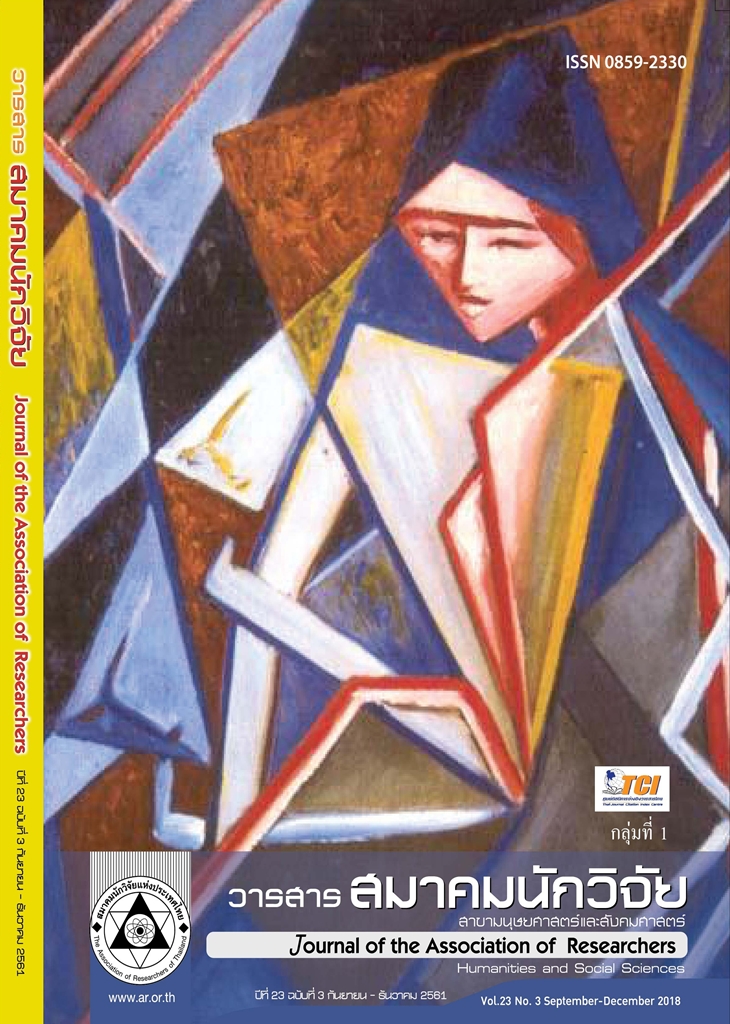Effects of Item Wordings and Types of Scale to Scale Scores avd Factor Sturcture of Personality Inventory
Main Article Content
Abstract
The purposes of this research were to study item wording (positive/negative) and response order (ascending/descending) affecting mean scores of personality inventory, item wording (positive/negative) and response order (ascending/descending) affecting reliability of personality inventory, item wording (positive/negative) and response order (ascending/descending) affecting factor structure of personality inventory and interaction effects between item wording (positive/negative) and response order (ascending/ descending) to mean score of personality inventory. Subjects in this study were 1,261 undergraduate students. Questionnaires were used as a research instrument. Statistics analyzed were percentage, mean, standard deviation, t-test, Two-way ANOVA, internal consistency, Factor Analysis, Comparison of internal consistency from independent samples by Feldt method and Tucker’s consistency coefficient. Results found that item wording (positive and negative) affecting mean scores of some factors (openness to experience and extraversion) of personality inventory, item wording (positive and negative) affecting reliability of some factors (openness to experience, conscientiousness and neuroticism) and response order (ascending and descending) scale affecting reliability of only one factor of personality inventory (agreeableness), item wording (positive/negative) and response order (ascending/descending) had no affect to factor structure of personality inventory and there was no interaction effects between item wording (positive/negative) and response order (ascending/descending).
Article Details
บทความที่ปรากฏในวารสารนี้ เป็นความรับผิดชอบของผู้เขียน ซึ่งสมาคมนักวิจัยไม่จำเป็นต้องเห็นด้วยเสมอไป การนำเสนอผลงานวิจัยและบทความในวารสารนี้ไปเผยแพร่สามารถกระทำได้ โดยระบุแหล่งอ้างอิงจาก "วารสารสมาคมนักวิจัย"
References
Chan, J.C. (1991). Response-order effects in Likert-type scales. Educational and Psychological Measurement, 51, 531-540.
Eys, M.A.; Carron, A.V.; Bray, S.R.; and Brawley, L.R., (2007). Item Wording and Internal Consistency of a Measure of Cohesion: The Group Environment Questionnaire. Kinesiology and Physical Education Faculty Publications. 16.
Feldt, L.S. (1969). A test of the hypothesis that Cronbach’s alpha or Kuder-Richardson coefficient twenty is the same for two tests. Psychometrika, 34, 363-373.
Feldt, L.S., Woodruff, D.J., & Salih, F.A. (1987). Statistical inference for coefficient alpha. Applied Psychological Measurement, 11, 93-103.
Gorsuch, R.L. (1983). Factor Analysis (2nd ed). Hillsdale, NJ: LEA.
Knowles, E.S., Nathan, K.T. (1997). Acquiescent responding in self-reports: Cognitive style or social concern ?. Journal of Research in Personality, 31 (2), 293-301.
Likert, R. (1932). A technique for measurement of attitudes. Archives of Psychology, 140, 5-55.
Lorenzo-Seva, U., & ten Berge, J.M.F. (2006). Tucker’s congruence coefficient as a meaningful index of factor similarity. Methodology, 2(2), 57-64.
Mathews, C.O. (1929). The effect of the printed response words on an interest questionnaire. Journal of Educational Psychology, 30, 128-134.
Nielsen, J. (2010). Horisontal attention leans left. Retrieved April 22, 2017. from https:// www. nngroup. com/ articles/ horizontal-attention -leans-left/
Podsakoff, P. M.; MacKenzie, S. B.; Lee, J-Y; Podsakoff, N. P. (2003). Common method biases in behavioral research: A critical review of the literature and recommended remedies”. Journal of Applied Psychology. 88 (5), 879–903.
Rorer, L.G. (1965). The great response-style myth. Psychological Bulletin, 63, 129-156.
Roszkowski, M.J., Soven, J. (2010). Shifting gears: Consequences of including two negatively worded items in the middle of a positively worded questionnaire. Assess Eval High Education, 35, 113-130.
Sonderen, E. v. , Sanderman, R. & Coyne, J.C. (2013). Ineffectiveness of reverse wording of questionnaire items: Let’s learn from cows in the rain. A Peer-Reviewed Open Access Journal, 8(7).
Swain, S.D., Weathers, D., & Niedrich, R.W. (2008). Assessing three sources of misresponse to reversed Likert items. Journal of Marketing Research, 45, 116-131.
Weijters, B. (2006). Response styles in consumer research. Doctoral dissertation, Ghent University, Ghent, Belgium. Weng, L.J. & Cheng, C.P. (2000). Effects of response order on Likert type scale. Educational and Psychological Measurement, 60(6), 908-924.
Wuensch, K. L. (2016). Comparing two groups’ factor structures: Pearson r and the coefficient of congruence. Retrieved August 16, 2017. from http://core.ecu.edu/psyc/wuenschk/ MV/FA/ FactorStructure-TwoGroups.docx.
Yomaboot, P., & Cooper, A. J. (2016). Factor structure and psychometric properties of the International Personality Item Pool-NEO (IPIP-NEO) Thai version. Journal of Somdet Chaopraya Institute of Psychiatry, 10 (2).


